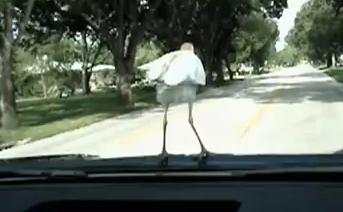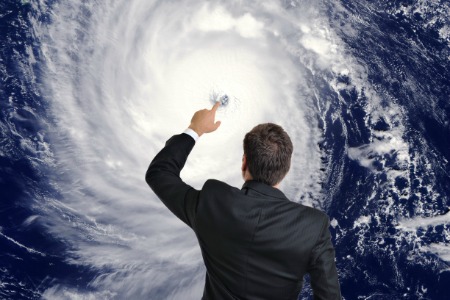 This week in Boston, Mass., the nation’s broadcast meteorologists will meet in their yearly conference sponsored by the American Meteorological Society (AMS). You probably don’t have it marked on your calendar, but from the point of view of the planet, it’s the most important meeting of weather reporters in history. Because the burning question in Beantown is whether weathercasters will embrace their responsibility to communicate how climate change is creating a new normal of dangerous, extreme weather.
This week in Boston, Mass., the nation’s broadcast meteorologists will meet in their yearly conference sponsored by the American Meteorological Society (AMS). You probably don’t have it marked on your calendar, but from the point of view of the planet, it’s the most important meeting of weather reporters in history. Because the burning question in Beantown is whether weathercasters will embrace their responsibility to communicate how climate change is creating a new normal of dangerous, extreme weather.
Given the climate change-fueled storms, heat waves, droughts, and wildfires that have dominated the past year, global warming will undoubtedly be a “hot” topic at this year’s conference. But, amazingly, many broadcast meteorologists remain lukewarm to the subject: The majority of weathercasters, including many with AMS certification, don’t believe that humans are causing climate change, let alone that it’s dramatically shifting our weather patterns. These meteorologists are missing the opportunity to be journalistic heroes who can inform the nation about our increasingly poisoned weather.
For those weathercasters who want education on the subject, the conference will have plenty to provide, with panels like “Applying Climate Change to Google Earth,” “Climate Change and Ocean Stories,” and “Hot Topics for the Station Scientist.” But the source of the climate communication deficit is mostly not educational, it’s about politics. The ideological bent of some forecasters, and the pressures to avoid “controversial” subjects that might affect ratings, are leading some meteorologists to ignore science when airtime arrives. That’s why the staff of Forecast the Facts will be attending the conference, carrying a message from thousands of our members: that reporting on global warming is a professional and moral responsibility. Below are just a few of their powerful comments:
You have a captive audience and no other single spokesperson would be better to educate people so they can effect changes in their own lives and in how we as a nation or community address and deal with correcting this problem that impacts us all. — Peggy B., Ocean Isle Beach, N.C.
Surely as scientists you know the realities of climate change. We must share this scientific evidence with as many in the public as we can before it is too late. You have a unique position where you can make a real difference and educate the public to this ever dangerous reality. Please use factual evidence to educate our citizens about the difference between weather and climate and to explain the greenhouse effect so that it is easily understood. Thanks for taking on this vital task. — James L., Hardwick, Mass.
Everyone watches the weather and relies on local forecasting. I’d very much appreciate local forecasters/weather experts making the connection between climate change and current weather patterns, based on the latest data, and helping the public to distinguish between long-term variation and short-term variation. You can make a big difference in educating, motivating, and driving critical behavior change. — Henry K., Sparks, Nev.
These Forecast the Facts members are not alone. Most Americans want their meteorologists to report on climate change. According to a March 2012 Yale/George Mason survey, two out of three Americans believe that global warming is changing our weather and want to learn more. The survey also found that 58 percent of Americans [PDF] “would be interested in learning what my favorite TV weathercaster has to say about global warming.” Even those who aren’t expressly asking for that information are clearly in need. Over the past six years, 80 percent of Americans have been affected by extreme weather. Their local meteorologists are the ones who can help them understand what’s going on, and whether they should expect more.
Thankfully, some meteorologists have already heeded these calls. WLTX Chief Meteorologist Jim Gandy of Columbia, S.C., does a weekly segment called Climate Matters, which explores how global warming is affecting the planet and his own community. KMGH-TV Chief Meteorologist Mike Nelson of Denver and WBOC-TV Chief Meteorologist Dan Satterfield of Salisbury, Md., run popular blogs that contribute both breaking weather alerts and informative explanations of how humans are changing the weather. And others, like WPRI-TV meteorologist TJ Del Santo of Providence, R.I., have done stand alone segments on the climate change-fueled heat wave.
These intrepid reporters deserve our sincere appreciation; Forecast the Facts members have already been showing them love online, and we’re excited to convey our thanks in person this week. But too many meteorologists still fall far short of this ideal. If this past year has taught us anything, it’s that when meteorologists refuse to accurately report on climate change, they quite literally put their viewers at risk.
Forecast the Facts is a grassroots community that exists to ensure that Americans receive accurate information about climate change. The growing incidence of climate-fueled extreme weather makes our work more urgent, and polls suggest that the recent heat waves, droughts, and mega storms are convincing the public that global warming is here. But whether Americans get the full story about these climate impacts depends largely on how the nation’s broadcast meteorologists report on the subject. We should know a lot more about where their community is headed after this week’s conference in Boston, and we’ll be filing daily dispatches to keep the public apprised.
The facts of climate change are now blowing in the wind. But the question remains: How many heat waves, droughts, wildfires, and megastorms must we have before weathercasters start to forecast the facts?




